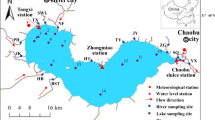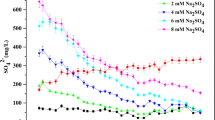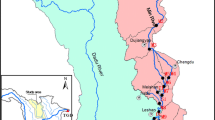Abstract
Lake Hamana is a semi-enclosed brackish lake amid agricultural and residential land. Monthly vertical profiles of nutrients, total phosphorus (TP), and total nitrogen (TN) at twelve sampling stations in the lake were obtained from 1995 to 2016. Freshwater samples were also obtained from five stations in the river flowing into the lake. Significant decreases were seen in phosphate, TP, and TN concentrations at most lake and all river stations. Decrease in phosphate concentration reflects reduced organic matter and nutrient load into the lake due to increased sewage coverage. Nitrate concentration significantly increased at four stations, whereas ammonium and TN concentrations significantly decreased. This could be due to inefficient nitrification/denitrification of wastewater. At all stations, the nitrogen to phosphate ratio in surface water was higher than 16 and increased significantly. Therefore, phosphate limitation could be strengthened by the decrease in phosphate and increase in nitrate concentrations in the lake.









Similar content being viewed by others
References
Amin MN, Kroeze C, Strokal M (2017) Human waste: an underestimated source of nutrient pollution in coastal seas of Bangladesh, India and Pakistan. Mar Pollut Bull 118:131–140
Boyer JN, Fourqurean JW, Jones RD (1999) Seasonal and long-term trends in the water quality of Florida Bay (1989–1997). Estuaries 22:417–430
Chen F, Jia G, Chen J (2009) Nitrate sources and watershed denitrification inferred from nitrate dual isotopes in the Beijiang River, South China. Biogeochemistry 94:163–174
Diaz R, Rosenberg R (1995) Marine benthic hypoxia: a review of its ecological effects and the behavioral responses of benthic macrofauna. Oceanogr Mar Biol 33:245–303
Ding Y, Rong N, Shan B (2016) Impact of extreme oxygen consumption by pollutants on macroinvertebrate assemblages in plain rivers of the Ziya River Basin, North China. Environ Sci Pollut Res 23:14147–14156
Gilbert RO (1987) Statistical methods for environmental pollution monitoring Willey New York p. 320
Hashimoto S (1989) High function activated sludge method utilizing biotechnology Gihodo Tokyo 276p (in Japanese)
Inoue K, Takeda S, Okamoto K, Furuya K (2005) Long-term changes in riverine nutrient loadings and bottom-water characteristics in the main basin of Hamana Bay. Bulletin on Coastal Oceanography (in Japanese with English abstract) 42:1141-1150
Japan Sewage Works Association (2017) Sewage statistics. Japan Sewage Works Association, Tokyo (in Japanese)
Jenny JP, Normandeau A, Frabcus P, Taranu E, Gregory-Eaves I, Lapointe F, Jautzy J, Ojala AE, Dorioz JM, Schimmelmann A, Zolitschka B (2016) Urban point sources of nutrients were the leading cause for the historical spread of hypoxia across European lakes. Proc Natl Acad Sci 113:12655–12660
Kadlec RH, Wallace SD (2008) Treatment wetlands, 2nd edn. CRC Press, Boca Raton, p 1000
Kubo A, Yamamoto-Kawai M, Kanda J (2015) Seasonal variations in concentration and lability of dissolved organic carbon in Tokyo Bay. Biogeosciences 12:269–279
Kubo A, Hashihama F, Kanda J, Horimoto-Miyazaki N, Ishimaru T (2019) Long-term variability of nutrient and dissolved organic matter concentrations in Tokyo Bay between 1989 and 2015. Limnol Oceanogr 64:S209–S222
Lee J, Park T, Kim M, Kim J, Lee S, Lee SK, Lee YS, Yu S, Rhew D (2016) Stable isotope on the evaluation of water quality in the presence of WWTPs in rivers. Environ Sci Pollut Res 23:18175–18182
Lefcheck JS, Orth RJ, Dennison WC, Wilcox DJ, Murphy RR, Keisman J, Gurbisz C, Hannam M, Landry JB, Moore KA, Patrick CJ, Testa J, Weller DE, Batiuk RA (2018) Long-term nutrient reductions lead to the unprecedented recovery of a temperate coastal region. Proc Natl Acad Sci 115:3658–3662
Liu C, Wang Q, Zou C, Hayashi Y, Yasunari T (2015) Recent trend in nitrogen flows with urbanization in the Shanghai megacity and the effects on the water environment. Environ Sci Pollut Res 22:3431–3440
Mazda Y (1999) Mystery of Lake Hamana: nature of inland water and seawater movement. Shizuoka Shimbun, Shizuoka (in Japanese)
Mayer B, Boyer E, Goodale C, Jaworski NA, Van Breemen N, Howarth RW, Seitzinger S, Billen G, Lajtha K, Nadelhoffer K, Van Dam D, Hetling LJ, Nosal M, Paustian K (2002) Sources of nitrate in rivers draining sixteen watersheds in the northeastern U.S.: isotopic constrains. Biogeochemistry 57(58):171–197
Ministry of Agriculture, Forestry, and Fisheries (2016) The census of agriculture and forestry (https://www.e-stat.go.jp/). Accessed 2019/8/12
Mortimer CH (1942) The exchange of dissolved substances between mud and water in lakes. J Ecol 30:147–201
Murphy J, Riley JP (1962) A modified single solution method for the determination of phosphate in natural water. Anal Chim Acta 27:31–36
Nixon SW (1995) Coastal marine eutrophication: a definition, social causes, and future concerns. Ophelia 41:199–210
Okamoto K (1995) Changes in macrofouling community in Shonai inlet, the Hamana Bay during recent 15 years. Marine Fouling 11:1–7
Redfield AC, Ketchum BH, Richards FA (1963) The influence of organisms on the composition of sea-water. Ed. Hill M.N. In The Sea. Interscience, New York, pp 26–77
Schmidt S, Bernard C, Escalier JM, Etcheber H, Lamouroux M (2017) Assessing and managing the risks of hypoxia in transitional waters: a case study in the tidal Garonne River (South-West France). Environ Sci Pollut Res 24:3251–3259
Solórzano L (1964) Determination of ammonia in natural waters by the phenolhypochlorite method. Limnol Oceanogr 14:799–801
Staehr P, Testa J, Carstensen J (2017) Decadal changes in water quality and net productivity of a shallow Danish estuary following significant nutrient reductions. Estuar Coasts 40:63–79
Strickland JDH, Parsons TR (1972) A practical handbook of seawater analysis. Bull Fish Res Board Canada 167:1–310
Tanaka Y, Kanno A, Shinohara R (2012) Effects of global brightening on primary production and hypoxic water in Ise Bay. J JSCE 68:1603–1608
Tong Y, Zhang W, Wang X, Couture RM, Larssen T, Zhao Y, Li J, Liang H, Liu X, Bu X, He W, Zhang Q, Lin Y (2017) Decline in Chinese lake phosphorus concentration accompanied by shift in sources since 2006. Nat Geosci 10:507–511
WWAP (United Nations World Water Assessment Programme) (2017) Wastewater: the untapped resource. The United Nations World Water Development Report 2017; UNESCO
Yue S, Wang C (2004) The Mann-Kendall test modified by effective sample size to detect trend in serially correlated hydrological series. Water Resour Manag 18:201–218
Zhang Y, Shi P, Li F, Wei A, Song J, Ma J (2018) Quantification of nitrate sources and fates in rivers in an irrigated agricultural area using environmental isotopes and a Bayesian isotope mixing model. Chemosphere 208:493–501
Acknowledgments
We thank the scientists and captain on board the R/V Hamana and acknowledge the members of the Shizuoka Fisheries Experimental Station Hamanako Branch and Shizuoka Institute of Environment and Hygiene for the sample measurement. We also thank Shino Yamauchi for making the original drawing of Fig. 9. We would like to thank Editage (www.editage.com) for English language editing.
Funding
This study was supported by the River Fund of The River Foundation, Japan.
Author information
Authors and Affiliations
Corresponding author
Additional information
Responsible editor: Boqiang Qin
Publisher’s note
Springer Nature remains neutral with regard to jurisdictional claims in published maps and institutional affiliations.
Electronic supplementary material
ESM 1
(DOCX 19 kb)
Rights and permissions
About this article
Cite this article
Kubo, A., Imaizumi, R. & Yamauchi, S. Lake water phosphate reduction with advanced wastewater treatment in watershed, at Lake Hamana, Shizuoka Prefecture, Japan, from 1995 to 2016. Environ Sci Pollut Res 27, 2120–2130 (2020). https://doi.org/10.1007/s11356-019-06947-5
Received:
Accepted:
Published:
Issue Date:
DOI: https://doi.org/10.1007/s11356-019-06947-5




